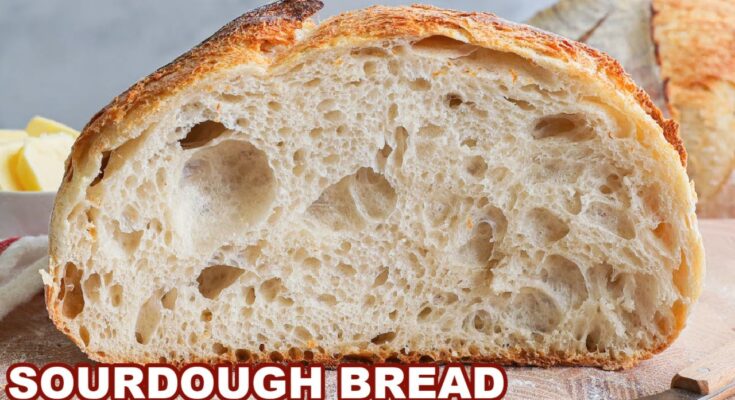Sourdough Bread Recipe: Sourdough bread has taken the baking world by storm, but it’s far from a new trend. In fact, this ancient technique has been around for thousands of years.
The combination of simple ingredients and slow fermentation gives sourdough its distinctive flavor, chewy texture, and crunchy crust.
Whether you’re a beginner baker or looking to elevate your bread-making skills, this guide will take you through the entire sourdough process step by step.
What is Sourdough Bread?
Sourdough bread is a naturally leavened bread made using a fermented mixture of flour and water, known as a starter, instead of commercial yeast. The wild yeast and bacteria in the starter cause the dough to rise and give the bread its signature tangy taste. Sourdough is known for its rustic appearance, airy crumb, and deliciously chewy texture.
Benefits of Making Sourdough Bread at Home
Health Benefits:
Sourdough is easier to digest than regular bread because the fermentation process breaks down gluten and phytic acid. It also has a lower glycemic index, making it a healthier option.
Taste and Texture:
Nothing beats the fresh, homemade flavor of sourdough. The crisp crust, soft interior, and unique tangy flavor are far superior to store-bought bread.
Essential Ingredients for Sourdough Bread
Sourdough bread only requires four ingredients:
- Flour: Bread flour is best for its high protein content, but all-purpose or whole wheat flour can be used.
- Water: Use filtered or bottled water to avoid the chlorine found in tap water, which can interfere with the starter’s activity.
- Salt: This not only enhances flavor but also strengthens the dough.
- Sourdough Starter: This is the heart of sourdough bread, full of natural yeast and bacteria to help the bread rise.
How to Make Your Own Sourdough Starter
Before you can bake sourdough bread, you need an active sourdough starter. The starter is what gives sourdough its rise and flavor.
What is a Sourdough Starter?
A sourdough starter is a mixture of flour and water that ferments over time, developing a culture of wild yeast and lactic acid bacteria. You can either get a starter from a friend or create your own from scratch. Here’s how:
Steps to Create a Starter from Scratch:
- Day 1: In a bowl, mix 1/2 cup of whole wheat flour with 1/4 cup of water. Cover loosely and let it sit at room temperature for 24 hours.
- Day 2-7: Each day, discard half of the mixture and feed it with 1/2 cup of flour and 1/4 cup of water. The mixture should start bubbling and rising as the yeast becomes active.
- After about a week, your starter should be ready for baking! It should double in size a few hours after feeding and have a tangy smell.
Tools You’ll Need for Sourdough Bread
While sourdough is simple in terms of ingredients, there are a few tools that will make the process easier:
- Mixing Bowls: For mixing and fermenting the dough.
- Bench Scraper: To divide and shape the dough.
- Dutch Oven: Provides the best environment for a crisp crust by trapping steam while baking.
Step-by-Step Guide to Making Sourdough Bread
Preparing Your Ingredients
First, make sure your sourdough starter is active. Feed it 4-6 hours before baking and wait for it to double in size.
Step 1: Mixing the Dough
In a large bowl, combine 500g of bread flour, 350g of water, 10g of salt, and 100g of sourdough starter. Mix with your hands or a spatula until there are no dry bits.
Step 2: Autolyse Process
Let the dough rest for 30 minutes to an hour. This helps the flour absorb the water and makes the dough easier to work with later.
Step 3: Kneading and Stretching
Every 30 minutes for the next 2 hours, perform “stretch and fold” techniques. Grab one side of the dough, stretch it, and fold it over. Rotate the bowl and repeat this process four times.
Step 4: Bulk Fermentation
Cover the dough and let it sit for 3-4 hours at room temperature. The dough should rise and become more elastic.
Step 5: Shaping the Dough
Turn the dough out onto a lightly floured surface. Shape it into a round or oval loaf by folding the edges into the center and pressing down gently.
Step 6: Proofing
Place the shaped dough into a floured proofing basket or bowl. Cover and let it proof in the refrigerator for 12-24 hours.
Step 7: Scoring and Baking
Preheat your oven to 475°F (245°C). Score the top of the dough with a sharp knife to allow steam to escape. Bake in a Dutch oven with the lid on for 20 minutes, then remove the lid and bake for another 25-30 minutes until golden brown.
Detailed Breakdown of the Fermentation Process
Fermentation is where the magic happens. The natural yeast in the starter ferments the sugars in the dough, producing gas that makes the bread rise. It also develops the flavor, giving sourdough its signature tang.
Common Mistakes to Avoid When Making Sourdough Bread
- Under-proofing or Over-proofing: If your dough is under-proofed, it won’t rise properly. Over-proofing can cause it to collapse.
- Not Maintaining the Starter Properly: Your starter needs regular feedings to stay active and healthy.
How to Tell if Your Sourdough Bread is Ready
- Visual Cues: The bread should have a golden brown crust.
- Sound and Texture: Tap the bottom of the loaf—if it sounds hollow, it’s done!
How to Store and Keep Your Sourdough Bread Fresh
To keep sourdough bread fresh, store it at room temperature in a paper bag or bread box. Avoid plastic as it traps moisture, making the bread soggy. You can also freeze sourdough bread by slicing it first and storing it in an airtight container.
Sourdough Bread Variations to Try
- Whole Wheat Sourdough
- Rye Sourdough
- Seeded Sourdough
Each of these variations brings different textures and flavors to the table.
Troubleshooting Common Sourdough Issues
- Dense Loaves: This could be due to under-proofing or a weak starter.
- Uneven Air Pockets: Often caused by improper kneading or shaping.
- Tough Crust: Baking at too high a temperature or not enough steam can cause this.
Why Patience is Key to Making Great Sourdough
Sourdough bread requires time and care. The slow fermentation and long proofing times allow the flavors to develop, and the dough to rise properly. Patience is essential for great results.
FAQs about Sourdough Bread Recipe
What is sourdough bread?
Sourdough bread is a type of bread made using a naturally fermented dough, typically consisting of flour, water, and a starter culture of wild yeast and lactic acid bacteria. This process gives sourdough its unique tangy flavor and chewy texture.
How long does sourdough bread take to make?
The process of making sourdough bread can take anywhere from 24 to 48 hours. While the active time is minimal, the long fermentation process is crucial for developing the bread’s signature flavor.
What makes sourdough bread healthier?
Sourdough bread is easier to digest than other breads due to the fermentation process, which breaks down gluten and increases the availability of beneficial nutrients. It’s also lower in sugar and often has a lower glycemic index.
Can I make sourdough bread without a starter?
No, a sourdough starter is essential for making authentic sourdough bread. The starter provides the natural yeast needed to ferment and leaven the dough.
What flour is best for sourdough bread?
Bread flour or all-purpose flour works best for sourdough bread due to its high protein content, which helps create a strong gluten structure. Some bakers also mix in whole wheat or rye flour for added flavor.
Conclusion
In summary, the Shepherd’s Pie recipe is a comforting, hearty meal perfect for any occasion. With its savory layers of flavorful ground meat, creamy mashed potatoes, and a hint of vegetables, this classic dish is both simple to prepare and satisfying for the whole family.
On a final note, the art of sourdough making is a rewarding experience that combines patience with creativity. From nurturing the starter to crafting a perfect loaf, each step brings a sense of accomplishment and a connection to time-honored baking traditions. Embrace the process, and enjoy the unique taste and texture of homemade sourdough.



